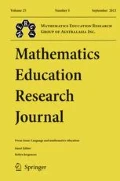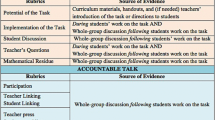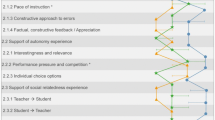Abstract
As part of a larger effort to improve teacher capacity for high-quality mathematics instruction, we investigated the factors that are associated with different enactment patterns at three levels: contextual (e.g., type and quality of textbook), individual (e.g., teacher knowledge), and teachers’ opportunity-to-learn (e.g., professional development experiences). Analysis of 183 teachers’ self-reports on their practices revealed three notable findings. First, the factors at the three levels were all found to be significantly related to the different patterns of enacted curriculum. However, the use of quality textbooks and the alignment of teachers’ views and instructional goals with curriculum goals were found to be the two factors that are most strongly associated with the enactment pattern of high-level problems and high-level teacher questions in instruction. Furthermore, teachers with the enactment pattern of increasing lower cognitive demand of problems into higher ones tended to rate their curriculum knowledge higher than teachers with the enactment pattern of using low-level problems and teacher questions in their teaching. In particular, deviation from and dissatisfaction with their assigned low-quality textbooks were found to be critical factors that are associated with the enactment pattern of increasing lower cognitive demands of problems in instruction.




Similar content being viewed by others
References
Anderson, L. W., & Krathwohl, D. R. (Eds.). (2001). A taxonomy for learning, teaching, and assessing: a revision of Bloom’s taxonomy of educational objectives. New York: Longman.
Apple, M. W., & Jungck, S. (1990). “You don’t have to be a teacher to teach this unit”: teaching, technology, and gender in the classroom. American Educational Research Journal, 27(2), 227–251.
Archambault, I., Janosz, M., & Chouinard, R. (2012). Teacher beliefs as predictors of adolescents’ cognitive engagement and achievement in mathematics. The Journal of Educational Research, 105, 319–328.
Boaler, J., & Staples, M. (2008). Creating mathematical futures through an equitable teaching approach: the case of Railside School. Teachers College Record, 110(3), 608–645.
Borko, H., Elliott, R., & Uchiyama, K. (1999). Professional development: a key to Kentucky’s reform effort. Los Angeles: National Center for Research on Evaluation, Standards, and Student Testing.
Boston, M. D., & Smith, M. J. (2009). Transforming secondary mathematics teaching: increasing the cognitive demands of instructional tasks used in teachers’ classrooms. Journal for Research in Mathematics Education, 40(2), 119–156.
Brown, M. (2008). Toward a theory of curriculum design and use: understanding the teacher-tool relationship. In B. Herbel-Eisenmann, J. Remillard, & G. Lloyd (Eds.), Mathematics teachers at work: connecting curriculum materials and classroom instruction (pp. 17–37). New York: Routledge.
Burbank, I. K. et al. (1987). Houghton mifflin mathematics Teacher’s edition, Level 4, Houghton Mifflin Canada Ltd.
Burstein, L., McDonnell, L. M., Van Winkle, J., Ormseth, T., Mirocha, J., & Guitton, G. (1995). Validating national curriculum indicators. Santa Monica: RAND.
Cohen, D. K. (1990). A revolution in one classroom: the case of Mrs. Oublier. Educational Evaluation and Policy Analysis, 12(3), 311–329.
Cooney, T. J. (1994). Teacher education as an exercise in adaptation. In D. B. Aichele & A. F. Coxford (Eds.), Professional development for teachers of mathematics, 1994 yearbook (pp. 9–22). Reston: National Council of Teachers of Mathematics.
Drake, C., & Sherin, M. G. (2002). Practicing change: Curriculum adaptation and teacher narrative in the context of mathematics education reform. Curriculum Inquiry, 36, 153–187.
Franke, M. L., Carpenter, T., Fennema, E., Ansell, E., & Behrend, J. (1998). Understanding teachers’ self-sustaining, generative change in the context of professional development. Teaching and Teacher Education, 14(1), 67–80.
Galant, J. (2013). Selecting and sequencing mathematics tasks: seeking mathematical knowledge for teaching. Perspectives in Education, 31(3), 34–48.
Goertz, M. E., Floden, R. E., & O’Day, J. (1995). Studies of educational reform: systemic reform. New Brunswick: Consortium for Policy Research in Education.
Hanley, U., & Torrance, H. (2011). Curriculum innovation: difference and resemblance. Mathematics Teacher Education and Development, 13(2), 67–84.
Henningsen, M., & Stein, M. K. (1997). Mathematical tasks and student cognition: classroom-based factors that support and inhibit high-level mathematical thinking and reasoning. Journal for Research in Mathematics Education, 28, 524–549.
Hosmer, D.W. & Lemeshow, S. (2004). Applied logistic regression. New York: Wiley.
Kadijević, Đ. M. (2002). TIMSS 2003 mathematics cognitive domains. Zbornik Instituta za pedagoška istraživanja, 34, 96–102.
Kilpatrick, J., Swafford, J., & Findell, B. (Eds.). (2001). Adding it up: helping children learn mathematics. Washington, DC: National Academy Press.
Kirk, D., & MacDonald, D. (2010). Teacher voice and ownership of curriculum change. Journal of Curriculum Studies, 33(5), 551–567.
Lewis, G. M. (2014). Implementing a reform-oriented pedagogy: challenges for novice secondary mathematics teachers. Mathematics Education Research Journal, 26, 399–419.
Mayer, D. P. (1999). Measuring instructional practice: can policymakers trust survey data? Educational Evaluation and Policy Analysis, 21(1), 29–45.
Mesa, V., & Griffiths, B. (2012). Textbook mediation of teaching: an example from tertiary mathematics instructors. Educational Studies in Mathematics, 79, 85–107.
Nie, B., Freedman, T., Hwang, S., Wang, N., Moyer, J. C., & Cai, J. (2013). An investigation of teachers’ intentions and reflections about using Standards-based and traditional textbooks in the classroom. ZDM, 45, 699–711.
Organisation for Economic Co-operation and Development. (2014). TALIS 2013 technical report. Paris: OECD.
Ott, L. R., & Longnecker, M. T. (2001). An introduction to statistical methods and data analysis (5th ed.). Pacific Grove: Duxbury.
Patton, M. Q. (1990). Qualitative evaluation and research methods (2nd ed.). Newbury Park: Sage.
Pólya, G. (1981). Mathematical discovery (Combinedth ed.). New York: John Wiley & Sons.
Remillard, J. T. (2005). Examining key concepts in research on teachers’ use of mathematics curricula. Review of Educational Research, 75(2), 211–246.
Remillard, J. T., & Bryans, M. B. (2004). Teachers’ orientations toward mathematics curriculum materials: implications for teacher learning. Journal of Research in Mathematics Education, 35(5), 352–388.
Sanders, N. M. (1966). Classroom questions: what kinds? New York: Harper & Row.
Schmidt, W. H., Raizen, S. A., Britton, E. D., Bianchi, L. J. & Wolfe, R. G. (1997). Many visions, many aims: A cross-national investigation of curricular intentions in school science. Dordrecht, The Netherlands: Kluwer
Shulman, L. S. (1987). Knowledge and teaching: foundations of the new reform. Harvard Educational Review, 57(1), 1–21.
Slavin, R., & Lake, C. (2008). Effective programs in elementary mathematics: a best-evidence synthesis. Review of Educational Research, 78(3), 427–515.
Sleep, L. (2012). The work of steering instruction toward the mathematical point: a decomposition of teaching practice. American Education Research Journal, 49(5), 935–970.
Son, J. (2008). Elementary teachers’ mathematical textbook use patterns in terms of cognitive demands and influential factors: a mixed method study. Unpublished doctoral dissertation, Michigan State University.
Son, J., & Crespo, S. (2009). Prospective teachers’ reasoning about students’ non-traditional strategies when dividing fractions. Journal of Mathematics Teacher Education, 12, (4), 236–261.
Son, J., & Kim, O. (2015). Teachers’ selection and enactment of mathematical problems from textbooks. Mathematics Education Research Journal, 27(4), 491–518.
Son, J., & Senk, S. (2010). How reform curricula in the USA and Korea present multiplication and division of fractions. Educational Studies in Mathematics, 74(2), 117–142.
Stein, M. K., & Lane, S. (1996). Instructional tasks and the development of student capacity to think and reason: an analysis of the relationship between teaching and learning in a reform mathematics project. Educational Research and Evaluation, 2, 50–80.
Stein, M. K., Grover, B. W., & Henningsen, M. A. (1996). Building student capacity for mathematical thinking and reasoning: an analysis of mathematical tasks used in reform classrooms. American Educational Research Journal, 33(2), 455–488.
Stein, M. K., Engle, R. A., Smith, M. S., & Hughes, E. K. (2008). Orchestrating productive mathematical discussions: five practices for helping teachers move beyond show and tell. Mathematical Thinking and Learning, 10(4), 313–340.
Stigler, J. W., & Hiebert, J. (2004). Improving mathematics teaching. Educational Leadership, 61(5), 12–16.
Sullivan, P., Clarke, D. J., Clarke, D. M., Farrell, L., & Gerrard, J. (2013). Processes and priorities in planning mathematics teaching. Mathematics Education Research Journal, 25(4), 457–480.
Supovitz, J. A., Mayer, D. P., & Kahle, J. B. (2000). Promoting inquiry-based instructional practice: the longitudinal impact of professional development in the context of systemic reform. Educational Policy, 14(3), 331–356.
Tarr, J. E., Reys, R. E., Reys, B. J., Chavez, O., Shih, J., & Osterlind, S. J. (2008). The impact of middle-grades mathematics curricula and the classroom learning environment on student achievement. Journal for Research in Mathematics Education, 39, 247–280.
Thompson, A. G. (1992). Teachers’ beliefs and conceptions: a synthesis of the research. In D. A. Grouws (Ed.), Handbook of research on mathematics teaching and learning (pp. 127–146). New York: Macmillan.
Van de Walle, J. V., Karp, K. S., & Bay-Williams, J. M. (2009). Elementary and middle school mathematics: teaching developmentally (7th ed.). New York: Virginia Commonwealth University.
Van Steenbrugge, H., Valcke, M., & Desoete, A. (2013). Teachers’ views of mathematics textbook series in Flanders: does it (not) matter which mathematics textbook series schools choose? Journal of Curriculum Studies, 45(3), 322–353.
Vygotsky, L. S. (1962). Thought and language. Cambridge: MIT Press.
Vygotsky, L. S. (1982). Sobraniye sochineni [Collected Works]. Moscow: Pedagogica.
Weiss, I. R., Pasley, J. D., Smith, P. S., Banilower, E. R., & Heck, D. J. (2003). Looking inside the classroom: a study of K-12 mathematics and science education in the United States. Chapel Hill: Horizon Research.
Wijaya, A., van den Heuvel-Panhuizen, M., & Doorman, M. (2015). Teachers’ teaching practices and beliefs regarding context-based tasks and their relation with students’ difficulties in solving these tasks. Mathematics Education Research Journal, 27, 637–662.
Wilson, S. M. (1990). A conflict of interest: the case of Mark Black. Educational Evaluation and Policy Analysis, 12(3), 293–310.
Wilson, S. M., & Berne, J. (1999). Teacher learning and the acquisition of professional knowledge: an examination of research on contemporary professional development. Review of Research in Education, 24, 173–209.
Yoon, K. S., Duncan, T., Lee, S. W.-Y., Scarloss, B., & Shapley, K. (2007). Reviewing the evidence on how teacher professional development affects student achievement (Issues & Answers Report, REL 2007–No. 033). Washington, DC: U.S. Department of Education, Institute of Education Sciences, National Center for Education Evaluation and Regional Assistance, Regional Educational Laboratory Southwest. Retrieved from http://ies.ed.gov/ncee/edlabs.
Author information
Authors and Affiliations
Corresponding author
Appendices
Appendix A
Questions for lesson plan modification
Suppose that you are planning to teach the concept of equivalent fractions to fourth graders. The next page shows a daily lesson. Would you use this lesson plan exactly as it is presented? _______ Yes _______ No
If no: Please describe in detail the modification(s) you would make, including your student objectives, classroom activities, problems, and questions you would use.


Source: Burbank, I. K. et al. (1987). Houghton Mifflin Mathematics Teacher’s Edition, Level 4, Houghton Mifflin Canada Ltd.
Appendix B
Appendix C
Rights and permissions
About this article
Cite this article
Son, JW., Kim, OK. Curriculum enactment patterns and associated factors from teachers’ perspectives. Math Ed Res J 28, 585–614 (2016). https://doi.org/10.1007/s13394-016-0181-3
Received:
Revised:
Accepted:
Published:
Issue Date:
DOI: https://doi.org/10.1007/s13394-016-0181-3




